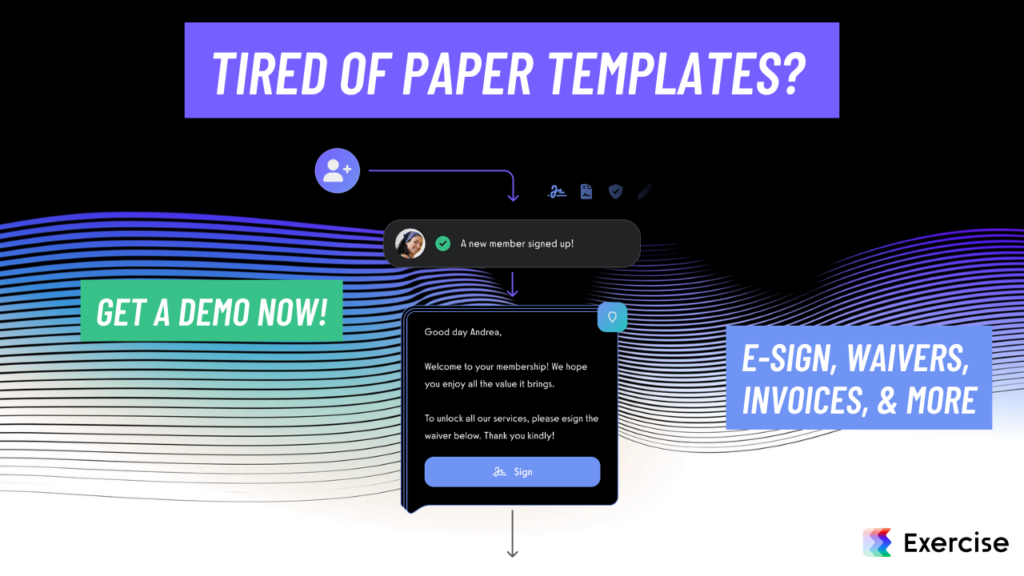Platform
Solutions
Industries
Compare
Resources
Posted by on July 14, 2023 — Updated on October 25, 2024
Use the free fitness class risk assessment template in PDF, DOC, and XLS to download and modify as needed.

Prioritizing safety in fitness classes is key. Use this free fitness risk assessment template download option to evaluate your fitness class safety requirements. If you are opening a gym or starting a fitness business, then be sure to also check out the gym risk assessment template to evaluate your entire gym, gym equipment, etc. Taking proper gym legal precautions are important not just to avoid gym lawsuits, but common gym complaints. Download the fitness class risk assessment form template, then be sure you have your fitness class waiver template, gym waiver template, fitness contract template, and more.
Are you a fitness instructor or gym owner looking to ensure the safety of your clients and staff? If so, it’s crucial to prioritize risk assessment in your fitness classes. In this article, we will explore why risk assessment is important and how you can use and modify the free fitness class risk assessment template below.

Ensure the safety of your fitness classes with our comprehensive risk assessment template. And, of course, managing your fitness business online with the best booking apps for fitness classes that come with the best gym management software and the best personal training software means that you can easily create fitness session plans, waivers, forms, fitness assessments (go here to check out the free fitness assessment template), lead forms, registration forms, online booking, workout plans, and much more—all with your very own custom branded fitness apps that seamlessly integrate with the best fitness class booking software.


FITNESS CLASS RISK ASSESSMENT
Class Name: [Name of the Fitness Class]
Instructor: [Instructor’s Name]
Location: [Location/Facility]
Date: [Assessment Date]
| Hazard | Risk Level (Low/Medium/High) | Affected Persons | Existing Control Measures | Additional Control Measures Needed | Responsible Person |
|---|---|---|---|---|---|
| e.g., Slippery Floor | Medium | Participants | Regular cleaning; Non-slip mats | Signage for wet areas | [Staff Name] |
| e.g., Equipment Use | High | Participants, Staff | Proper training; Regular checks | Emergency stop buttons on machines | [Staff Name] |
Assessment Conducted by: [Name and Title]
Signature: ___________ Date: _______________
Approval by Facility Manager/Owner: [Name and Title]
Signature: ___________ Date: _______________
Note: This template provides a general framework and may require customization to suit the specific class, location, and other unique factors. It’s recommended to consult with a legal or safety professional to ensure compliance with local regulations and standards. If you’re a fitness professional looking for a platform that provides an all-in-one solution for running your business, including risk management, consider booking a demo with Exercise.com. The custom branded fitness app is designed to meet the multifaceted needs of the fitness industry.

A Fitness Class Risk Assessment Template is an essential tool for identifying potential risks and hazards within a fitness class environment. It allows you to take proactive measures to minimize those risks and ensure the safety and well-being of both instructors and participants. Here’s a general gym equipment risk assessment template to guide you. Use the fitness risk assessment template for evaluating fitness risks, and then modify as needed to create an exercise risk assessment template that you can use for certain exercises that are inherently riskier than others.
If you’re looking for a complete software solution to manage various aspects of your fitness business, including risk assessments, consider Exercise.com. Booking a demo with Exercise.com can show you how their custom branded fitness app is tailored to meet the needs of fitness professionals, offering features like online booking, payment processing, hosting exercise videos, and more.


In fitness classes, there are inherent risks that need to be identified and managed. By conducting a risk assessment, you can proactively identify potential hazards and take steps to mitigate them. Not only does this ensure the safety of your participants and staff, but it also demonstrates your commitment to providing a secure environment for everyone involved in your fitness classes.
Furthermore, risk assessment in fitness classes helps to minimize the likelihood of accidents and injuries. By identifying potential risks, such as faulty equipment or inadequate space, you can implement preventive measures to reduce the chances of accidents occurring. This not only protects the well-being of your participants but also helps to maintain a positive reputation for your fitness classes.
Read More:
Before diving into the details of creating a risk assessment template, it’s essential to understand the basics of risk assessment. This process involves identifying hazards, assessing the likelihood and severity of potential risks, and implementing control measures to minimize or eliminate those risks.
When conducting a risk assessment for fitness classes, you need to consider various factors such as the equipment used, the nature of the exercises, the experience level of participants, and the layout of the class environment. By carefully evaluating these elements, you can develop an effective risk management plan.
One important aspect to consider when conducting a risk assessment for fitness classes is the instructor’s role in ensuring safety. The instructor should have proper training and certification in fitness instruction and should be knowledgeable about potential risks and how to mitigate them. They should also be able to effectively communicate safety guidelines and instructions to participants, ensuring that everyone understands and follows them. Additionally, the instructor should be vigilant during the class, monitoring participants for any signs of discomfort or potential injury and making necessary adjustments to minimize risks. By having a competent and attentive instructor, the overall safety of the fitness class can be greatly enhanced.
Using a fitness class risk assessment template offers several benefits. Firstly, it provides a structured approach to identifying and managing risks, minimizing the chances of overlooking critical hazards. The template serves as a comprehensive document that guides you through the risk assessment process, ensuring consistency and thoroughness.
Additionally, a template allows for easy collaboration and communication among your staff members involved in risk assessment. Everyone can have a common understanding of the expectations and procedures for risk assessment, enhancing overall safety measures and reducing the likelihood of accidents.
Another benefit of using a fitness class risk assessment template is that it saves time and effort. With a pre-designed template, you don’t have to start from scratch every time you conduct a risk assessment. The template already includes relevant sections and prompts, making it easier and quicker to complete the assessment.
Furthermore, using a template can help ensure compliance with industry standards and regulations. The template can be designed to align with specific guidelines and requirements, ensuring that your risk assessment process meets the necessary standards. This can be particularly important in industries where safety regulations are strict and non-compliance can result in penalties or legal consequences.
Creating an effective fitness class risk assessment template requires careful consideration of the specific risks associated with your classes. Start by outlining the various areas of concern, such as equipment safety, instructor qualifications, and participant health screenings. Once you have identified these key elements, you can design a template that covers each aspect in detail.
Within the template, include prompts and guidelines for assessing risks, evaluating control measures, and monitoring risk mitigation actions. It’s important to strike a balance between providing comprehensive information and keeping the template user-friendly and easy to navigate.
When creating a fitness class risk assessment template, there are several key elements that you should consider including:
By including these elements, you can develop a comprehensive risk assessment template that addresses all potential areas of concern in your fitness classes.
Now that you understand the importance of risk assessment and have created a template, let’s walk through a step-by-step guide to conducting a risk assessment for fitness classes:
Following this step-by-step guide will help you systematically assess and manage risks, creating a safer environment for your fitness classes.
When conducting a risk assessment for fitness classes, it’s essential to be aware of common risks and hazards. Some of the common risks include:
By familiarizing yourself with these risks, you can take proactive measures to prevent accidents and injuries in your fitness classes.
Identifying and assessing potential risks in your fitness class environment is a critical part of the risk assessment process. Start by thoroughly reviewing your class setup, equipment, and facilities. Look for any areas that could pose risks, such as uneven flooring, inadequate ventilation, or lack of emergency response protocols.
Once potential risks are identified, evaluate the likelihood and severity of each risk. Consider the number of participants, their fitness levels, and the intensity of the exercises performed. By assessing these factors, you can prioritize risks and implement appropriate control measures.
Mitigating risks in fitness classes involves taking proactive measures to reduce or eliminate potential hazards. Here are a few strategies to help you effectively manage risks:
By utilizing these strategies and consistently referring to your risk assessment template, you can significantly reduce the likelihood of accidents and injuries in your fitness classes.
To ensure compliance and safety with your fitness class risk assessment template, it’s important to regularly review and update it. Changes in regulations, industry best practices, or the class environment may require modifications to your risk assessment procedures.
Additionally, train your staff on the proper usage of the risk assessment template. Ensure they understand its purpose, how to complete it correctly, and the actions to take in response to identified risks. Ongoing staff training will help maintain compliance and safety in your fitness classes.
Training staff on using the fitness class risk assessment template effectively is key to ensuring its proper use. Consider conducting regular staff training sessions where you can explain the purpose and importance of risk assessment, demonstrate how to complete the template, and address any questions or concerns.
Encourage open communication among your staff members and emphasize the importance of reporting and addressing any identified risks promptly. By fostering a culture of safety and vigilance, your staff will be better equipped to use the risk assessment template effectively and ensure the overall well-being of your fitness classes.
To maintain the effectiveness of your fitness class risk assessment template, follow these best practices for reviewing and updating it:
By adhering to these best practices, you can continuously improve your risk assessment template and maintain a safe environment for your fitness classes.
Looking for real-life examples of how a fitness class risk assessment template can improve safety? Consider these case studies (these are composites based on real-life examples):
Case Study 1: A fitness instructor used a risk assessment template to identify a worn-out exercise mat in the class environment. By promptly replacing the mat, they prevented a potential slipping hazard and ensured the safety of their participants.
Case Study 2: A gym manager implemented a comprehensive risk assessment template that included participant health questionnaires. Through these questionnaires, they identified a participant with a pre-existing heart condition. By working closely with the participant’s doctor, they developed an appropriate exercise plan, preventing potential cardiac episodes.
These case studies demonstrate how the use of a fitness class risk assessment template can lead to actionable improvements and ultimately create a safer environment for fitness classes.
When creating a fitness class risk assessment template, be mindful of these common mistakes:
By being aware of these mistakes, you can take proactive steps to avoid them and create a more effective risk assessment template for your fitness classes.
Each fitness class environment is unique, so it’s important to customize your risk assessment template to fit your specific needs. Consider these tips:
By following these tips, you can tailor your risk assessment template to the specific requirements of your fitness classes, enhancing safety and overall risk management.
As a fitness professional, prioritizing risk assessment in your classes is essential to ensure the safety and well-being of your participants and staff. By using a fitness class risk assessment template and following the step-by-step guide outlined in this article, you can proactively identify and manage risks, create a secure environment, and emphasize your commitment to excellence in fitness class safety. Don’t leave anything to chance—take control of your class’s risk assessment today!
Risk assessments are crucial in any fitness environment, including gyms, fitness classes, and personal training sessions. They help in identifying and evaluating potential risks, ensuring that proper precautions are taken. Here’s how you can conduct a risk assessment in a fitness context:
You can create a template using tools like Microsoft Word or Excel. It might include:
Examples might include:
A checklist is a systematic tool used in risk assessment to ensure that all potential hazards have been considered. It can include items related to equipment safety, emergency procedures, staff training, environmental factors, etc.
Yes, if you’re competent in understanding the risks associated with your particular environment, you can write your own risk assessment.
Risk templates are pre-designed formats used to conduct a risk assessment. They can help standardize the process across different areas of a business.
A simplified risk assessment is a more basic and straightforward approach to identifying and evaluating risks. It might be suitable for smaller operations or less complex environments.
A basic risk assessment follows the essential steps of identifying, evaluating, controlling, and reviewing risks without delving into overly complex or specialized analyses.
Exercise.com is a comprehensive software solution for fitness professionals, including gym owners, personal trainers, and online coaches. Its capabilities include:
By using Exercise.com, you can run your entire fitness business more efficiently and effectively. It provides a professional solution for managing clients, tracking progress, and growing your business. Booking a demo can help you explore how Exercise.com can be tailored to meet your specific needs and goals.


 Tyler Spraul
Tyler Spraul